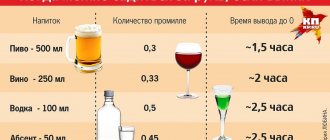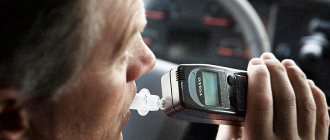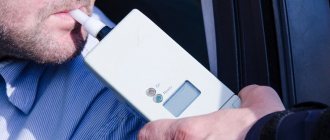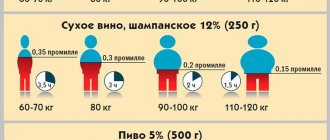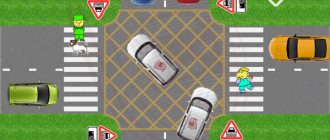Blood alcohol level
What is ppm? This is one thousandth of something, it equals 0.1%. If they say that there is 1 ppm of alcohol in the blood, this means that in a liter of blood 0.1% ethyl alcohol is 1 gram.
Degrees of intoxication and number of ppm. Doctors use this table:
| Degree of intoxication | Alcohol in blood, ppm |
| light | 1-2 |
| average | 2-3 |
| heavy | 3-4 |
| "alcohol coma" | 4 and above |
Period of complete elimination from the body in hours. The rate of elimination of ethyl alcohol from the body is on average 0.1-0.2 ppm per hour. The speed is affected by the following parameters: height, weight and gender. For example, 100 ml of vodka after 6 hours will not leave any traces in the body of a man weighing 80 kg and height 175 cm.
What is ppm?
Let's start with the fact that ppm is not the alcohol content in the blood or exhalation. This is a tenth of a percent, that is, a thousandth of a unit. In ppm you can measure anything: from the increase in profit of a stall in some village to the demographic situation in Russia.
Promille refers to the percentage of alcohol in the blood. That is, if a medical examination reveals 1.42 ppm, this means that a person has 0.00142 liters of alcohol per liter of blood.
How to check your blood alcohol level
A drunk driver is a danger to himself and to other road users. It is precisely because of the increased danger that the punishment for such citizens is especially severe, and the government, by a separate order, approved the rules for testing drivers for intoxication. Here are the main points.
Reasons for checking. If the inspector has reason to believe that the driver is drunk, he will send him for a medical examination. Reasons are one or more signs of driver intoxication:
- smell of alcohol from the mouth;
- stands unsteadily;
- speaks incoherently;
- the face quickly turns red or pale;
- behaves inappropriately to the situation, for example, waving his arms and shouting.
On-site inspection. The driver is told the testing rules and is asked to exhale into a special device - a breathalyzer. The driver can get out of his car, but is not required to. The inspector knows how many ppm you are allowed to drive in 2021, and therefore can send you for a re-inspection.
Re-check. If the device detects at least 0.16 milligrams of alcohol per liter of exhaled air, the driver will be asked to blow into the tube again after 15-20 minutes.
Protocol. If during the second test the device again shows the same result, the driver will be declared drunk and a report will be issued about this. The inspector will send this protocol to the court. If the breath alcohol tester does not show any results, the driver will be released.
Check with a health worker. A driver will be sent to be checked at a medical facility or mobile medical examination center if he:
- refused on-site inspection;
- does not agree with the results shown by the inspector’s device;
- still drunk according to the inspector. This is possible if the device has been in the cold for a long time or, in the opinion of the inspector, is faulty.
The health worker will test the exhaled air and military materials - urine and blood - for alcohol.
If the driver is found to have alcohol, the medical worker makes a note about this in the report - the traffic police officer attaches this document to the protocol and sends it to the court.
In all cases where the test results show that the driver is drunk, the car is sent to the impound lot. Let us remind you that the permissible amount of ppm in exhaled air in 2021 is 0.3.
Falsification of tests. Some drivers try to give the doctor fake urine or dilute it with water. At mobile and stationary urine testing points there are special booths where drivers make the change.
But doctors check temperature, acidity, density and several other parameters that allow them to establish the fact of falsification. If the health worker discovers this, he will make a note about it in the report.
Substitution according to the law is equal to refusal of examination. And the punishment for this is a fine of 30,000 rubles with deprivation of rights for up to 2 years.
More modern breathalyzer models have a miniprinter - it prints the test result. The inspector will attach this printout to the protocol. Source: draeger.com
Acceptable ppm rate for drivers in Russia
› › Free legal consultation: (MSK), (SPB) Most drivers understand what punishment awaits them for driving while intoxicated.
However, ethanol is also found in the body of people who did not drink alcohol at all on the eve of the trip. A number of medications, as well as food products, provide this effect. So, how much ppm is allowed and will not cause a fine?
Every driver is required to know about the permissible levels of ethanol in the blood established by law.
Strict adherence to these indicators allows citizens to drive motorized vehicles. Let's consider how many ppm are allowed in order not to violate traffic regulations, and also to prevent the creation of emergency situations while driving.
It is known that strong drinks and medicines contain alcohol. In addition, alcohol is present in a number of food products. This substance, when consumed, causes a state of intoxication:
- visual acuity is impaired.
- coordination of movements and mental abilities are impaired;
- the body's reactions slow down;
- attention quickly dissipates after taking alcoholic substances;
- the functioning of the cerebral cortex is inhibited;
Permille is a quantitative value.
It makes it possible to determine the degree of intoxication after consuming substances containing ethanol. This indicator allows you to detect the presence of alcohol in the body.
Thus, 1/10 of a ppm indicates the content of 0.045 mg of ethyl alcohol in 1 liter of blood. Ethanol takes a long time to disappear from the human body.
This fact must be taken into account before consuming strong drinks, food, medicine, if you will soon be driving a car. If a citizen drinks 100 g of vodka, it will take about 5 hours to drive. After drinking a glass of wine, you can drive no earlier than 4 hours.
Let's consider how many ppm are allowed while driving for all drivers without exception.
How to appeal the results of an inspection
Errors in the protocol. If the case goes to court and the driver has arguments in his own defense, he can report errors when drawing up the protocol:
- there were no witnesses or video recording of testing;
- the information in the document does not correspond to the facts, for example, the driver’s words are distorted;
- Incorrect data: names, dates or places.
Errors in testing. During testing, the driver is required to exhale into a special tube that is attached to the breathalyzer itself - a mouthpiece. The inspector should only use a new tube - remove it from its sealed packaging. This is necessary so that after the previous inspection there are no traces of saliva or alcohol left in the tube, and also to exclude forgery on the part of the inspector.
If the driver notices that the mouthpiece is already on the device, he must insist that this fact be recorded in the protocol.
Modern breathalyzers are equipped with a mini-printer - the driver must pay attention to the data in the printout, which the inspector will attach to the protocol. If it does not contain today’s date or the readings are clearly exaggerated, you need to mention this in the protocol or not sign the document at all. Inflated readings, for example, are as follows: the driver drank a mug of weak beer, but the device shows that he drank a bottle of vodka - this is 2.5 ppm. This is much higher than the ppm allowance for driving in Russia in 2021.
Also, at the driver’s request, the inspector must show documents for the breathalyzer, indicating that the device is registered and in working order. To check whether the device is registered, you need to go to the website of the register of approved measuring instruments and enter “ethanol” in the “Name of measuring instruments” column.
Next, through the search on the page, find the word “exhaled” or words similar to it. Search on a page - keyboard shortcut Ctrl+F on Windows or ⌘+F on Mac
As a result, you will find information about all registered devices. If the test was carried out with a device that is not registered, this will help to challenge the data from the protocol.
If the driver wants to retest the blood and urine, for example, in a private laboratory, he can do this - the samples are stored in the medical institution for three months. And the results obtained using special devices last for 5 years.
In any case, when the driver does not agree with the verification procedure, he has the right not to sign the protocol.
Measuring the alcohol content of drivers - ppm law from July 3, 2021
On April 3, 2021, it was published to clarify the procedure for establishing the fact of the use of substances that cause alcohol intoxication. Information began to spread in the media that to determine the state of intoxication, the unit of measurement is being returned - ppm.
- ;
- ;
- ;
Changes are made in a note to Article 12.8 of the Code of Administrative Offenses of the Russian Federation.
Let's take a closer look at the new law and what changes actually await us.
The article defines the responsibility for driving a vehicle by drivers who are in a state of intoxication.
BEFORE AFTER Note: Administrative liability provided for by this article and part 3 of article 12.27 of this Code occurs in the event of an established fact of consumption of substances that cause alcohol intoxication, which is determined by the presence of absolute ethyl alcohol in a concentration exceeding the possible total measurement error, namely 0.16 milligrams per liter of exhaled breath. air, or in the case of the presence of narcotic drugs or psychotropic substances in the human body.
Note. Administrative liability provided for by this article and part 3 of article 12.27 of this Code occurs in the event of an established fact of consumption of substances that cause alcohol intoxication, which is determined by the presence of absolute ethyl alcohol in a concentration exceeding the possible total measurement error, namely 0.16 milligrams per liter of exhaled breath. air, or the presence of absolute ethyl alcohol in a concentration of 0.3 or more grams per liter of blood, or in the case of the presence of narcotic drugs or psychotropic substances in the human body.
Alcohol can be detected either by the alcohol content in your breath or by the alcohol content in your blood. The alcohol content in the blood can only be determined in a laboratory with blood sampling.
When blowing through a breathalyzer, it is possible to determine only the alcohol content in the exhaled air.
Article: Dismissal of an employee who is intoxicated (Konopatskis M.M.) (“Trade Expert”, 2008, n 5)
“Trade Expert”, 2008, N 5 TERMINATION OF AN EMPLOYEE WHO IS IN A STATE OF ALCOHOL INTOXICATION The law establishes a limited list of grounds for dismissal of employees at the initiative of the employer.
This can be considered as an essential guarantee of the right to work. Some grounds for dismissal are related to the employee’s fault, others - to production-related circumstances (reduction in staff, number), and still others - to the personal qualities of the employee (inconsistency with the work performed). Guilty behavior of an employee is a serious violation of labor discipline.
In this regard, clause 6, part 1, art. 81 of the Labor Code of the Russian Federation provides for such grounds for dismissal as a single gross violation by an employee of his labor duties. A single gross violation by an employee of his labor duties can be the reason for the dismissal of any employee. Such violations include, in particular, absenteeism and the employee appearing at work in a state of alcohol, drug or other toxic intoxication.
Often in practice, the question arises on which of these two grounds should an employee be dismissed (for example, if the employee is not allowed into the enterprise by the company’s own security service due to the fact that the person is intoxicated). Dismissal of an employee for absenteeismIn the Labor Code of 1971. provided for such grounds for termination of the employment contract as absenteeism.
At the same time, the semantic meaning of this word was somewhat different. Absenteeism was understood as an employee’s failure to show up for work without good reason during the entire working day (work shift). Absenteeism was the absence of an employee from work for more than three hours in a row or in total during a working day (work shift) without good reason.
Currently, in accordance with paragraphs. “a” clause 6, part 1, art. 81 of the Labor Code of the Russian Federation, absenteeism is understood as the absence of an employee from the workplace without good reason during the entire working day (shift), regardless of its duration, as well as absence from the workplace without good reason for more than four hours in a row during the working day (shift). ).
Is it possible to mitigate the punishment or fine?
The judge may impose a minimum term of imprisonment of 1.5 years instead of 2 years.
Alexander Torvard, car lawyer For drunk driving, in addition to a fine, there is a “delta” of penalties - a period of deprivation of rights from 1.5 to 2 years. When determining the term, the judge will take into account mitigating and aggravating circumstances. Mitigating factors include, for example, remorse, the presence of dependents and the absence of previous violations. These circumstances cannot completely exempt you from liability. Aggravating circumstances include repeated violation of the law under the same article of the code or unwillingness to admit to the crime.
Responsibility of drunk driving
Persons found to be intoxicated while driving will face administrative penalties. If road users (pedestrians, passengers of other vehicles) are injured due to their fault, criminal liability may arise.
If a driver is found to have exceeded the permissible ethanol content for the first time, he will be fined. Transport control will become unavailable to him for some time.
A repeated offense will result in the penalty rate being increased many times over. In addition, a citizen who violates the law may be deprived of the right to drive a vehicle or punished with forced labor.
If it is discovered that a fined person was driving a car while intoxicated, that is, he committed a new offense while serving an old one, he will suffer a more severe punishment than specified in the sanction of the article.
Drivers must also understand that their unmotivated refusal to take an alcohol test and examination at a medical facility is an indirect admission of guilt for driving while intoxicated. At the same time, it is almost impossible to prove your innocence in such a situation.
We suggest that you familiarize yourself with: Usn Compensation for Material Damage to Income - Read Answer || Payment of compensation for material damage, tax accounting
The owner of a motor vehicle will be fined if he gives control of the car to a drunk driver. In addition, the violator is subject to punishment in the form of deprivation of his driver's license.
Let's look at the degree of responsibility for citizens who, while drunk, hit pedestrians on the roadway:
- If the injured person received minor injuries, the person responsible for the accident faces administrative liability.
- If a pedestrian is injured in an accident and suffers serious bodily harm, the culprit faces a prison sentence. In addition, the driver may be subject to forced labor and deprived of his driver's license.
- In the event of an accident resulting in the death of a pedestrian, the drunken citizen faces imprisonment for a long term. At the same time, his rights are also taken away. If the accident resulted in the death of two or more people, the drunk driver will go to prison. The court will set a specific sentence for him based on the proven circumstances of the case and other data.
The legislation of different states differs depending on the legislator and the legal system. If you understand the requirements of foreign laws, you will be able to avoid getting into an unpleasant situation when traveling by car, or simply develop your horizons. Please note that in most countries, blowing through a straw is not used; a blood test is taken and the alcohol concentration is determined.
In Spain
0.3 ppm is allowed, because any device can give errors and show a small alcohol level. At 0.5, a mild degree of intoxication begins, which means corresponding responsibility begins. It is noteworthy that for those who do not have much driving experience, the standard is set to 0, that is, the slightest fraction of ppm can lead to a fine or other punishment. By the way, a similar situation is observed in Portugal, Croatia and many European countries.
In Belarus
For citizens of the Republic it is allowed to use:
- For men weighing up to 80 kg, 0.5 liters of beer, the strength of which does not exceed 6 degrees. For representatives of the fairer sex, whose weight does not exceed 65 kg - 0.33 liters.
- Men are allowed to drink 50 g of cognac, women 30 g.
- Regarding wine, men have the right to afford 125 g of drink, women 75.
It is important to remember the anatomical features, weight and height, and fullness of the citizen’s stomach. All this affects the final result. According to the law of Belarus, no more than 0.3 ppm of alcohol is allowed.
In Ukraine
The Ministry of Internal Affairs of Ukraine issued Order No. 400, which sets the permissible level of alcohol in the human body at the federal level. It is 0.2 ppm. This is the lightest and lowest degree of intoxication, it is called preclinical, that is, it has no accompanying symptoms.
Officially, the traffic police of the Ministry of Internal Affairs of the DPR established several degrees of intoxication:
- The lightest is from 0.5 to 1.5 ppm.
- Average – from 1.5 to 2.5.
- Increased – from 2.5 to 3.
- Severe, poisoning with products containing alcohol - from 3 to 5 ppm.
When checking a driver, no more than 0.3 ppm is allowed on a breathalyzer. Increased indicators are grounds for detaining a person and imposing punishment on him.
In Germany
The German legislative system is not simple, so alcohol also has its own peculiarities. For example, a driver who is caught under the influence of alcohol will have to pay a fine of 500 euros, the next time the fine increases to 1000 euros, and for the third offense 3000 euros.
The maximum permissible value is 0.5 ppm. If the driving experience is less than 2 years, or if the driver has not reached 21 years of age, not the slightest indicator is allowed, that is, the device must indicate 0. The same rule applies to taxi drivers. If the offender is caught for the third time or the first time, but the dose is 1.6 ppm or more, the police officer will refer the person for testing. It costs 500 euros, and based on the results, the person is either sent to re-enroll in school or loses his or her rights.
In Finland
State legislation allows alcohol concentrations of no more than 0.5 ppm. Otherwise, the driver faces arrest, imprisonment or more severe punishment. The authorities categorically prohibit novice and inexperienced drivers from being in a state of any kind of intoxication. The principles of liability are identical to those laid down in Germany.
In Italy
Italy is a typical European country, which is characterized by strict sanctions and established standards of intoxication. The allowed blood alcohol content is no more than 0.5 ppm. For an indicator above 0.5 but less than 0.8, the driver will have to pay a fine of 160 euros. For an increased concentration of alcohol you may be subject to deprivation of rights for up to 8 months and a fine of 700 euros.
At the legislative level, control over drivers is assigned to traffic police officers; they are the ones who serve on the road, participate in preventive measures and ensure safety. Issues of liability for drunk driving are regulated by the norms of the Criminal Code of the Russian Federation and the Code of Administrative Offenses. In addition, there are a number of Government Resolutions and Orders of the Ministry of Internal Affairs of the Russian Federation that relate to the activities of the traffic police and the examination procedure.
Driving while drunk is strictly prohibited in the Russian Federation and many countries of the world community. In order to monitor the condition of drivers, a device such as a breathalyzer is used. It allows you to determine the ppm content in the human body. You learned everything about this unit of measurement and drunk driving in general. Good luck on your journey and remember that you take responsibility for your behavior and the consequences that may occur!
According to existing legislation, you cannot be fined if an analysis shows that the motorist has less:
- 0.3 g per 1 liter of blood;
- 0.16 ‰ in exhaled air.
This dose is allowed by law. This amount of ppm in the blood is considered the maximum possible. The amendments were adopted after it was proven that after consuming some common foods and medications, a breathalyzer test shows the presence of alcohol.
We suggest you read: What tax is withheld from wages
A person’s ability to control their behavior depends on the amount of alcohol in the blood:
- mild euphoria - 0.2–0.3 ‰;
- feeling of looseness, high self-esteem - 0.4–0.6 ‰;
- increased conflict, decreased coordination of movements - 0.7–0.9 ‰;
- significant impairment of motor coordination, incoherent speech, aggression, slow reactions, vision problems - 1.0–1.2 ‰;
- poisoning of the body, accompanied by a complete loss of control over one’s body; vomiting, feeling of fear - 1.3–1.5 ‰.
At an alcohol concentration of 2.0 ‰, memory loss occurs and the feeling of pain disappears. Further increase in dose leads to complete intoxication and death.
The human body is able to metabolize ingested alcohol. It takes the liver several hours to neutralize the toxic substance. The rate of toxin removal depends on the following factors:
- amount of alcohol-containing drink consumed;
- person's weight;
- growth;
- nationality;
- gender;
- consumption rates;
- individual reaction;
- heredity.
A thin woman of short stature will get drunk faster than a man about 40 years old, 185 cm tall and weighing more than 90 kg. A member of the stronger sex will become sobered up faster if he drinks the same dose of alcohol as a woman.
The situation is the same if we compare the ability to tolerate alcohol among the Slavs and the small peoples of the North. The body of a Russian, Ukrainian, or Belarusian is less susceptible and eliminates alcohol faster than that of the Nanai and Evenks. Europeans also have innate resistance.
Table 1 - The rate of complete neutralization of alcohol depending on individual indicators
When an examination reveals that the blood of the person driving the car contains an unacceptable amount of ppm, he will face serious punishment.
If a car owner gives his car to a drunk person, he will face the same punishment as the driver. Drinking alcohol leads to an increase in the dose of alcohol in the blood. The person behind the wheel is unable to react to the rapidly changing situation on the road.
Even more severe punishment awaits those who repeatedly violate the law.
Remember
- The amount of ppm alcohol allowed in 2021 is 0.3 ppm in exhaled air.
- The inspector has the right to check the driver if he cannot stand, speaks incoherently or behaves inappropriately.
- The driver may not agree with the test results and insist on medical testing.
- If you refuse to check completely, the law will equate it to drunk driving.
- If the driver does not agree with the results of the check, he can reflect this in the protocol or not sign the protocol at all. Then you will have to prove your case in court.
- If alcohol is detected above the ppm alcohol limit in Russia in 2021, the driver will be deprived of his license for up to 3 years and fined 30,000 rubles.
- A mitigation of the punishment is possible - the judge can reduce the period of deprivation of rights to 1.5 years.
All articles by the author: Evgeniy Lesnov
How are degrees of intoxication determined?
Well, we told you what the permissible alcohol limit in ppm is when tested on a breathalyzer at a factory or at a traffic police post.
In conclusion, we will briefly explain how the degrees of intoxication are determined. They allow you to assess the level of change in a person’s behavior (behavioral signs) and the approximate amount of alcohol consumed.
The degree of intoxication can be mathematically accurately determined by the result of the breathalyzer readings in ppm (normal or exceeded), as well as a chemical laboratory blood test.
Below are the officially approved standards:
| ‰ in blood | ‰ in exhalation | Degree |
| Up to 0.3 | Up to 0.16 | 0 acceptable (person is sober) |
| 0,4-1,5 | 0,16-0,65 | 1 mild (relaxation, talkativeness, elevated mood, slight impairment of coordination and speech) |
| 1,6-2,5 | 0,65-1,25 | 2 average (slurred speech, mood swings, aggression, poor coordination, uneven gait) |
| 2,5-3 | 1,25-1,5 | 3 strong (cloudy consciousness, almost complete loss of coordination, spontaneous bowel movements and urination may occur) |
| 3-5 | 1,5-2 | 4 severe (no memory, consciousness, coordination, partial damage to the nervous system, possible organ failure) |
| More than 5 | More than 2 | 5 potentially fatal (emergency medical attention required) |
The range of results of most professional and personal breathalyzers is set to an interval of 0-1.9‰. Simply, a large concentration of ethanol in the exhalation is fatal for most people. Outwardly, it is easy to understand that the permissible limit has been exceeded even at a slight degree of intoxication.
Remember, a breathalyzer will not tell you how much you are allowed to drink before you are banned from driving. He will only calmly and calmly display the numbers on his scoreboard. We hope this will be your personal device, and not an official breathalyzer in the hands of a traffic cop.
Reader Questions
Answer: No, the information is incorrect, this amount of ppm is detected by a breathalyzer after consuming kumiss and kvass.
Answer: Wait for a new trial, which will result in a fine of 200 to 300 thousand rubles and deprivation of rights for 36 months. It is possible to work up to 480 hours on compulsory public works (cleaning and removing garbage, cleaning toilets, sweeping streets).
Answer: The state of complete sobering in large men with heavy weight occurs earlier than in persons with a thin physique. Heredity and the moral and physical state of a person mean a lot. If your friend is bigger than you, he could very well sober up 2-3 hours earlier. If tested simultaneously, the alcohol content in the exhaled air of two representatives of the stronger sex will be different.
Answer: Officially allowed in 2021 is less than 0.3 g per 1 liter of blood and less than 0.16 ‰ in exhaled air.
Many people who like to drink alcohol while driving claim that they feel great and their state of intoxication does not prevent them from controlling the situation on the road. In fact, as numerous medical experiments show, in most drivers, even with a minimum amount of ppm in the blood, the ability to quickly react, control their own movements, and analyze the situation changes.

